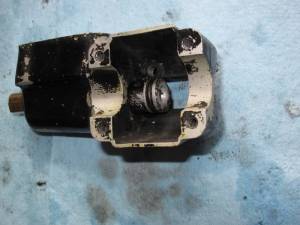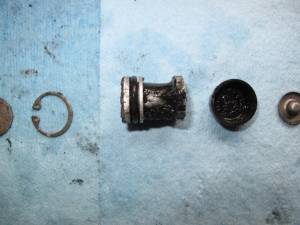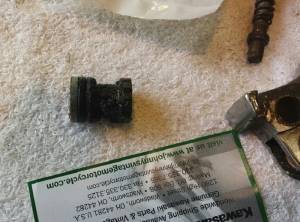Table of Contents
REF: Wheels, Brakes & Tires
Brake Fluid
Brake Fluid Shelf Life
Subdocuments
- Storage Area:
- Store undercover, away from moisture and direct sunlight in well-ventilated area.
- Storage Temp:
- The majority of brake fluid manufacturers suggest storing unopened sealed containers between 20C (68F) and 40C (104F).
Note: different brands list different storage temps so check your fluid manufacturer for actual storage temp suggested.
- Storage Time:
- The storage time (or shelf life) includes from the time the bottle was sealed at the manufacturer, not when you bought it.
- Some brands publicize the shelf life of their brake fluid but most do not.
- As can be seen from the chart below, different brands will list different shelf life of their brake fluid.
- Lot Number:
- Every bottle of brake fluid should have a lot number printed somewhere on the label or bottle.
The lot# should include the date it was bottled.
The date within the lot# may be variations of Month-Day-Year or a Julian style date code. - If the lot number is faded or unreadable, don't buy/use it. It may have already died on the shelf before you bought it.
- If ordering thru mail, check the lot# when you receive it.
- You can call the manufacturer and ask for replacement or refund if it's past the shelf life date (or just dispose the bottle)
- You can also call them and ask how to read the date on the bottle.
The chart below was compiled from Technical Data Sheets (TDS), read as public flyers, from different brake fluid manufacturers.
No endorsements are implied. All brake fluids brands are not listed. The list is for shelf life comparison (or not) only.
Brands (only) are listed since each brand below listed the same storage info for each DOT type fluid they sell.
| Brand | Date Code on Bottle | Unopened Shelf Life |
| ACDelco | At least five years. 1) | |
| Notes | When stored under appropriate conditions in original closed containers at max temp of 40°C. | |
| ATE | Up to 5 years from Born On date in the original sealed container. 2) | |
| Bardahl | 2 Years in original container. 3) | |
| Belray | XXXXJJJY | 3 Years from Born On date in original sealed container. 4) |
| Notes | Example date code printed on bottle (XXXX = internal use, JJJ = Julian date, Y = year). So a lot# of (80482867) was made October 13, 2017 |
|
| Castrol | Not specified in TDS 5) | |
| Dento | 6) | |
| DuPont | 7) | |
| Genuine Chemistry (GC) | Not specified in TDS 8) | |
| Gulf | Not specified in TDS 9) | |
| HD Expert | Up to one year after the date of manufacture in original sealed container. 10) | |
| Lucas | Not specified in TDS 11) | |
| Mobile | YYYY.MM.DD.D | 3 Years from Born On date in original sealed container. 12) |
| MOL | 3 Years from Born On date in original sealed container. 13) | |
| Morris | Not specified in TDS 14) | |
| Prestone | Not specified in TDS 15) | |
| Shell | Not specified in TDS 16) | |
| Spec Oil | Not specified in TDS 17) | |
| Veedol | Not specified in TDS 18) | |
When to Check or Change Brake Fluid
DOT3,4 and 5.1 Brake fluids tend to absorb humidity from the air.
This reduces the boiling point and increases the risk to get to a “vapor lock” phenomena. 19)|
Over time, brake fluid absorbs water from hoses, seals, etc., which also may reduce its boiling point and impair braking performance.
Most brake fluid manufacturers suggest following your vehicle manufacturer's change intervals.
In the absence of vehicle manufacturer specifications, it is generally suggested to change fluid at least every 2 years.
Copper content is the most destructive aspect of brake fluid breakdown.
So even without moisture being present in the fluid, it is still a good idea to change the fluid when it is suppose to be changed. 20)
HD Recommendations
| Year Model | Hydraulic brake fluid Type |
|---|---|
| 1959 to prior to Sept. 1976 production models | DOT 3 21) |
| Sept. 1976 to 2006 | DOT 5 (99902-77) 22) 23) |
| 2007 and later | DOT 4 24) |
| Year Model | Check | Change |
|---|---|---|
| 1959-1969 | ||
| 1970-197825) | Every 2,000 miles | Every 5,000 miles |
| 1979-198526) | Initial 500, then every 2,500 miles | Every 2 years |
| 1986-199027) | Check at initial 500 then every 5,000 miles, prior to storage or annually | Change/ Replace as needed |
| 1991 to 200328) | Every 300 til and including initial 1,000 miles, then every 5,000 miles | Replace as needed |
Testing Your Brake Fluid
- Check water solubility
- What Type Brake Fluid Do You Have?
- 1st check your bikes service manual to see what should go in it.
The master cylinder cover should have the type fluid stamped into it also.
Understand that the PO or Indy may have changed fluid type without your knowledge too. - Next, get a few drops of brake fluid from your brake reservoir and put them in a small container. Add a few drops of water and mix it all together.
- If the water mixes with the brake fluid, it is DOT 3, 4 or (5.1).
- If the water does not mix with the brake fluid it is DOT 5. 29)
- The Color Check
- The presence or absence of color is not a safe criteria to distinguish between the different types of brake fluids.
The color is added in brake fluid to detect leaks and color does not effect the quality of brake fluid.
Since blue and purple sometimes can seem the same color depending on lighting, you could be mixing Dot 5 and DOT (5.1).
(not to mention DOT 5 turning clear and making you think someone changed to a different type than OEM for your year model…. this does happen.) - Test for moisture content:
This test is a result of an SAE paper showing a distinct relationship between moisture content and the voltage measured. 32) - Brake fluid (3,4 & 5.1) is hygroscopic (able to draw in moisture like a sponge).
It is no wonder, then, that the brake fluid in the master cylinder is often dark, almost black in appearance.
But does that mean it has to be changed? Not always.
Glycol based fluid absorbs moisture and disperses it throughout the system.
Silicone based (5) fluid does not allow moisture to enter the system. So this test may not work for DOT 5 fluid. 33)
(since it's the moisture inside the fluid that makes the reaction)
And while there are test strips to test the moisture content,
Here is a method that works just as well.
Use your DMM (Digital Multimeter) to test the fluid. - The procedure is easy enough.
- Hook up your negative meter lead to the negative battery post.
- Insert your positive meter lead into the brake fluid while avoiding contact with the reservoir itself.
- Any reading over 0.30 volts is too much, and the fluid should be flushed.
Mixing Brake Fluids
- Mixing different colors of the same type typically won't hurt the system.
(as long as what you are adding to has not been compromised previously if your just topping off your existing fluid) - You can typically mix DOT 3,4 and 5.1 fluids without damaging your braking system or compromising your existing braking performance.
But as nearly every brake fluid manufacturer will state: doing so is not recommended.
Mixing good new fluid and old bad fluid means you will retain the bad fluid's performance.
(and change the temperature ratings of your residual fluid)
You can't mix any others with Dot 5 fluids.
Mixing the others into Dot 5 would cause a meltdown of the rubber parts and / or a break down of the silicone
(and possibly clog up the brake lines causing brake failure)
Dot 5 into the others may release clogs into the brake lines also leading to brake failure. - If silicone is introduced into an older brake system;
The silicone will latch onto the sludge generated by gradual component deterioration and create a gelatin like goop.
(which will attract more crud and eventually plug up metering orifices or cause pistons to stick)
If you have already changed to DOT 5, don't compound the problem and change back.
You will never get all of the silicone out of your system. Just change the fluid regularly.
For those who race using silicone fluid;
Crack the bleed screws before each racing session to insure that there is no water in the calipers. 34)
Swapping Brake Fluid (Dot 3 to Dot 5)
The following is found in HD Technical Service Bulletin M-712 dated June 16,1977.
When changing from D.O.T. 3 to D.O.T. 5 fluid or when flushing the brake system, it is important that D.O.T. 3 fluid be removed completely.
Old fluid could be contaminated with water and if mixed with the new D.O.T.-5 fluid, it would detract from it's effectiveness.
The old fluid could also cause varnish deposits if the system is operated above the boiling point of D.O.T. 3.
Caution should be used when bleeding because any brake fluid on the pad will contaminate the pad material and reduce brake effectiveness.
The fluid absorbed by the pads cannot be removed satisfactorily with any solvent nor by operating the brakes.
Procedure:
- Disconnect the brake lines from the master cylinder and wheel calipers (wheel cylinders if drum brakes).
Catch old fluid in container and discard. - Remove master cylinder and brake calipers from motorcycle.
- Disconnect brake hoses from the metal brake lines (if applicable).
- Flush the metal brake lines several times with silicone brake fluid (D.O.T. 5) fluid to remove all the old fluid.
Solvent flushing is not recommended. - Replace the brake hoses with new ones.
- Disassemble the master cylinder and wheel calipers or cylinders.
- Drain and remove any residual D.O.T. 3 brake fluid with a dry, clean cloth that will not leave lint or grit on the master cylinder or caliper parts.
- Replace master cylinder and wheel caliper rubber seals, piston cups and 0-rings with new parts.
- Coat pistons, piston bores and rubber parts with silicone brake fluid and reassemble.
- Install master cylinder and calipers on motorcycle.
- Reassemble brake lines to master cylinder and calipers.
- Fill brake system with D.O.T.-5 silicone brake fluid and bleed air from system following procedure in Service Manual.
Fluid leakage from the rear master cylinder boot after bleeding is often caused by excessive piston travel due to air in the system.
The boot should be wiped clean of any brake fluid to avoid contaminating the cylinder with road dust.
DOT 3, DOT 4, DOT 5.1
- DOT 3 brake fluids are mixtures of glycols and glycol ethers. DOT 4 contains borate esters in addition to what is in DOT 3. These brake fluids are somewhat similar to automotive anti-freeze (ethylene glycol) and are not a petroleum fluid. Both DOT 3-4 and DOT 5 fluids are compatible with most brake system materials except in the case of some silicone rubber external components such as caliper piston boots 37)
- The problem with DOT 3-4 fluids is water absorption. DOT 3-4 glycol based fluids, just like ethylene glycol antifreezes, are readily miscible with water. Long term brake system water content tends to reach a maximum of about 3%, which is readily handled by the corrosion inhibitors in the brake fluid formulation. Since the inhibitors are gradually depleted as they do their job, glycol brake fluid, just like anti-freeze, needs to be changed periodically. 38)
- Fluid boiling point DOT 4 glycol based fluid has a higher boiling point (446F) than DOT 3 (401F), and both fluids will exhibit a reduced boiling point as water content increases.39)
- DOT 5.1 is also glycol-based and it's major difference to Dot 3 and 4 is it's dry boiling point (minimum 518F).
DOT 5
- The change to Dot 5 brake fluid was made with HD production motorcycles in September of 1976 40). It is of silicone chemistry and not being water miscible, it must rely on the silicone (with some corrosion inhibitors) as a barrier film to control corrosion. Water is not absorbed by silicone as in the case of DOT 3-4-5.1 fluids, and will remain as a separate globule sinking to the lowest point in the brake system, since it is more dense. 41)
- When using Dot 3 brake fluid, the brake system should be drained, flushed, and refilled with new brake fluid every year to eliminate any contamination such as sludge. This yearly service was eliminated when D.O.T.-5 silicone fluid was used instead and with improved performance. 42)
- Silicone brake fluid reduces corrosion, will not degrade the “rubber” components, and sludge will not form in the system. It will not absorb water, does not attack painted parts, and has a higher boiling point than conventional brake fluid. When stored under normal conditions it has unlimited shelf life. However, it is somewhat harder to bleed brakes with Dot 5 because of its viscosity. 43)
- Dot 5 in its pure state offers a higher boiling point (500F) however if water got into the system, and a big globule found its way into a caliper, the water would start to boil at 212F causing a vapor lock condition (possible brake failure). DOT 3 fluid with 3% water content would still exhibit a boiling point of 300F. Silicone fluids also exhibit a 3 times greater propensity to dissolve air and other gasses which can lead to a “spongy pedal” and reduced braking at high altitudes. 44)
Brake Fluid Boiling Points
- Dry Boiling Point: This is the temperature that your brake fluid will boil when its straight out of the sealed bottle. When there has been effectively no time for it to absorb any moisture. If you are racing on a track, you are most concerned with this value, since the fluid in your lines is likely to be freshly added. 45)
- Wet Boiling Point: This is the temperature that your brake fluid will boil when its been inside your braking system for a reasonably long time. How long it takes to get to this saturation point will vary by fluid type, but a good rule of thumb is the higher the dry boiling point, the faster the fluid will saturate (an informal sort of standard is…not always - used by fluid manufacturers: the wet boiling point is the reading taken after fluid has been sitting for one year in your brake lines). If you are riding mainly on the street the wet boiling point is going to be the one you want to pay attention to since the fluid will typically stay in your brake lines for an extended period of time. 46)
SAE Testing Brake Fluid Lubricity
- SAE is currently working on modernizing testing and standards for automotive brake fluids. Below are the standards that relate to brake fluid and their corresponding standard number.
- J1703- Motor Vehicle Brake Fluid Jul 20, 2015
- J1704- Motor Vehicle Brake Fluid Based Upon Glycols, Glycol Ethers and the Corresponding Borates Jul 20, 2015
- J1705- Low Water Tolerant Brake Fluids Apr 21, 2014
- J1707- Service Maintenance of SAE J1703 and J1704 Brake Fluids in Motor Vehicle Brake Systems
Links to Brake Fluid Comparison Charts on the Web
- Interesting amateur test on mixing brake fluids http://www.buckeyetriumphs.org/technical/Brakes/Fluid/Fluid.htm



